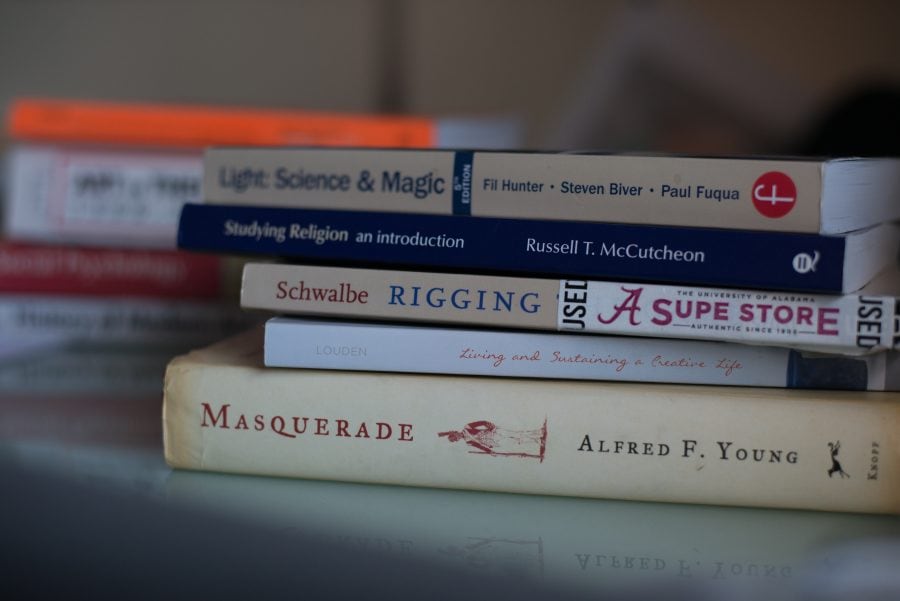If there is one thing that college students hate more than staying up late reading textbooks, it’s taking their wallets out to pay for them. The American textbook industry has dominated the marketplace for a long time, and the power it holds is only growing as textbook prices continue to rise.
For the 2016-2017 school year, the College Board recommended that students budget an average of $1,200 for their textbooks and a recent study by the Government Accountability Office (GAO) found that the price of textbooks rose 82 percent between 2003 and 2013. That is nearly three times the rate of inflation for any other good.
The “big three” textbook companies that make up this group—McGraw Hill Education, Pearson, and Houghton Mifflin Harcourt—have long held a monopoly over textbooks and this stranglehold is starting to hurt a student’s education.
According to a 2014 CNBC report, 65 percent of students decided against buying textbooks because they were too expensive and 94 percent of students who skipped out on buying textbooks expressed concern that it may hurt their academic success.
Some students think they may have the solution to this rapidly growing problem. Last year, University Student Government Association Sen. Mike Smith proposed his Open Textbook Act, which passed the SGA Senate unanimously.
“Basically, what it did was, it encouraged The University of Alabama to apply for a grant provided by the Bill and Melinda Gates Foundation and Rice University,” Smith said. “There’s this program called OpenStax, and there are about 20 free, online textbooks available to any student to use nationwide.”
Smith, a junior economics major, stressed the importance of adopting this program and said he thinks it is imperative that The University of Alabama adopt the program as soon as possible. Smith also expressed concern over the rising price of textbooks.
“I think the rising price of textbooks hurts a lot of students’ ability to gain knowledge… and it restricts the free flow of knowledge that college is supposed to foster,” Smith said. “There’s this broken economic model. It’s not consumers and producers; there’s this third external party, so there’s not any competition.”
Like Smith, many students are leaning toward a system of cheaper—or even free—online textbooks as a solution to the problem.
“I honestly think that the best idea for counteracting rising textbook prices is just to have more online textbooks and cheaper online textbooks,” said Sofia Helene, a sophomore psychology major. “Because online textbooks are already usually close to the price of the printed copy.”
As education becomes increasingly technologically innovated, the “big three” textbook companies have started moving to online systems. However, they can be just as expensive as a physical copy.
An analysis from the Student Public Interest Research Groups found that the average price of a stand-alone access code costs an average of $100, and this price can go up to an average of $126 if it must be bundled with a copy of the textbook.
Other students think schools should abandon textbooks altogether.
“Textbooks don’t have any unique knowledge in them,” said Kevin Brothers, a junior economics major. “Almost everything that’s in a textbook you can find on Google, so the fact that we have to pay for these books of limited knowledge to carry around with us is kind of dumb.”
Brothers said he thinks the solution is to have a free database available online.
“It should really just be an online system or some sort of way in which information is freely available to everyone, like a library, but on the internet,” he said. “You could do it even through BlackBoard, just one massive database.”
As prices continue to rise, textbook publishers are experiencing an increasing amount of pressure to respond.
In reaction to the GAO report, publishers told investigators from the agency “they have made these investments to meet changing needs of higher education, such as the increase in part-time faculty who require greater instructional support and supplements that will enhance student learning of the subject matter.”
The report clarifies: “While these materials are provided at no cost to instructors, the cost of developing them is built into the price of the textbook.”
The big three’s domination of the textbook market is becoming increasingly worrisome to many students as they continuously struggle to foot the bills.
“[The rising price of textbooks] is a monumental financial burden on the student body here at UA and at every college nationwide,” Smith said. “I think it’s absolutely ridiculous, and it hurts the ability for students to learn.”







